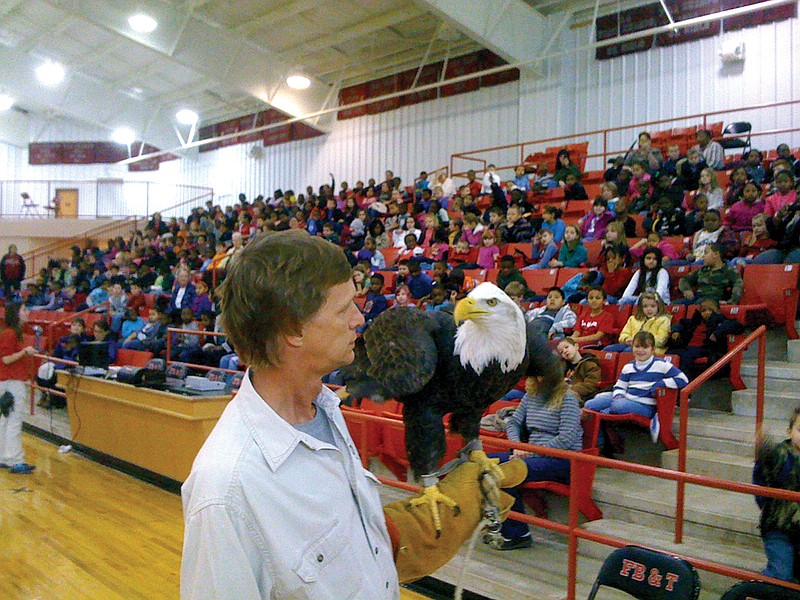BISMARCK — On the weekend of Jan. 25-27, DeGray Lake Resort State Park will celebrate the eagles that winter around the lake, along with other birds of prey, at Eagles Et Cetera 2013.
Before the eagle festival begins, park interpreters, along with docents from the Little Rock Zoo, will give young students from around the region a chance to see the birds up close.
“The zoo usually brings about a dozen different birds, including all four owl species found in Arkansas, the horned, barn and two kinds of screech owl,” said Elizabeth Bittner, an interpreter at the state park. “There will be several species of hawks, a kestrel and a vulture.”
The educational program for the schools has been offered for 10 years, and Bittner said more schools have been signing up for a visit by the birds in recent years.
“The program can be adapted for any age, from pre-K to eighth grade, and we could do one for high school classes,” she said. “Around 200 to 300 students see the program at each school, and I would say the average kid seeing the show is between third and fifth grades.”
Carla Collette, educational curator at the Little Rock Zoo, said the program is a rare opportunity to study the birds up close.
“We don’t call it a show; these birds are wild, not circus animals that perform. They are ambassadors for all the birds of prey living in their natural habitat,” she said. “There are animals of all sizes, from the kestrel, the smallest American falcon that weighs less than a pound, to the bald eagle that is about 12 pounds.”
One unique bird that is not like many of those in the wild is an extraordinary white red-tailed hawk.
“She is not an albino, but she had no pigment in her feathers,’” Collette said. “She was born in the wild and was not doing well, so she was brought in to be protected.”
Along with the small kestrel, the owls are always popular with the students, said Guy Bingham, who has been a docent with the zoo for 12 years and has been trained to handle the eagle.
“One of the larger birds is Gomez, a vulture known in Arkansas as the turkey buzzard,” said Bingham, who is certified each year to handle the birds. “You have to pay attention. These are still wild animals.”
Generally, he said, the animals perch on a stick or on his gloved hand. The animals wear anklets, like those worn by hunting falcons, that the handler holds.
“Sometimes the eagle will try to bay, or jump to the ground, and you can’t let them do that, so you hold on,” Bingham said.
Park interpreter Jason Parrie, who has accompanied the birds on their school outings for 7 years, said he likes to watch the reactions of the children when the eagle is brought out at the end of the hour-long show.
“While they love seeing the hawks and owls, when the eagle comes out the excitement levels go way up,” Parrie said. “It just reminds you of the power that the bald eagle inherently has to inspire. That is why it is so important that the kids get a chance to see the birds up close.”
Bingham said the eagle likes it, too.
“Lynn is mellow,” he said of the zoo’s bald eagle that makes the school visits. “Sometimes she will even fluff up her feathers and then pick at them, which is a sign of her comfort.”
Bingham said Lynn has her own special story.
“She was hatched in 1994 and was selected to be one of the first bald eagles to be reintroduced into Arkansas,” he said. “A year or so later, she was found injured near Jonesboro and brought into a bird rehab facility. Well, the rehab place was hit by a tornado, and she was injured again, so they decided she could not be released again, and she became an educational bird, representing all the other eagles in Arkansas.”
Bittner said the park sets aside funds to pay half of the $300 program fee so schools only have to be responsible for $150. The money supports the Little Rock Zoo’s educational program, and the park also lodges the docents who volunteer and take time from their jobs to make the school presentations.
Following is the schedule for the birds of prey program in the Tri-Lakes Edition coverage area:
• Jan. 22: Westbrook Elementary School in Benton, 9 a.m.; and Gardner Magnet School in Hot Springs, 1:30 p.m.
• Jan. 23: Hot Springs Middle School, 9 a.m.; and Caddo Hills Elementary School in Norman, 1 p.m.
• Jan. 24: Clinton Primary School in Hope, 9 a.m.; and Centerpoint Intermediate School in Amity, 1:45 p.m.
• Jan. 25: Summit School/Vista Alternative Learning Environments in Hot Springs, 10 a.m.; and Peake Elementary School in Arkadelphia, 1:15 p.m.
For more information about DeGray Lake Resort State Park, call (501) 865-5810 or visit www.degray.com.
Staff writer Wayne Bryan can be reached at (501) 244-4460 or wbryan@arkansasonline.com.
